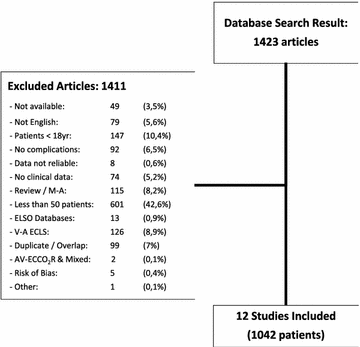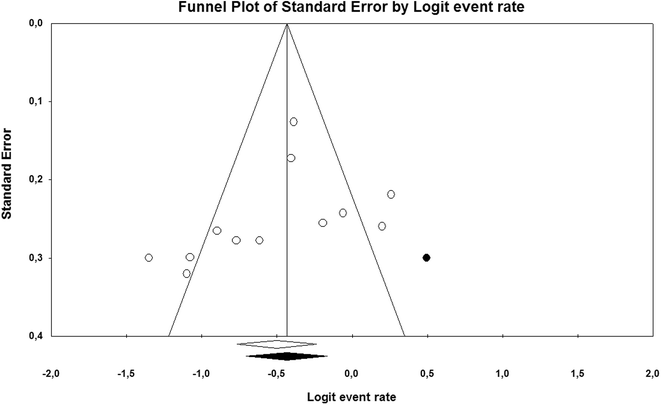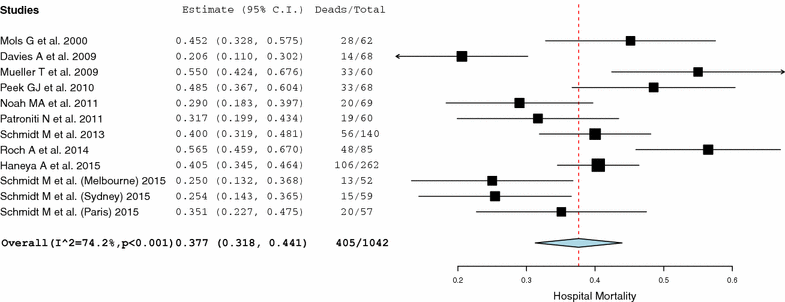Systematic review and meta-analysis of complications and mortality of veno-venous extracorporeal membrane oxygenation for refractory acute respiratory distress syndrome
- PMID: 28500585
- PMCID: PMC5429319
- DOI: 10.1186/s13613-017-0275-4
Systematic review and meta-analysis of complications and mortality of veno-venous extracorporeal membrane oxygenation for refractory acute respiratory distress syndrome
Abstract
Veno-venous extracorporeal membrane oxygenation (ECMO) for refractory acute respiratory distress syndrome (ARDS) is a rapidly expanding technique. We performed a systematic review and meta-analysis of the most recent literature to analyse complications and hospital mortality associated with this technique. Using the PRISMA guidelines for systematic reviews and meta-analysis, MEDLINE and EMBASE were systematically searched for studies reporting complications and hospital mortality of adult patients receiving veno-venous ECMO for severe and refractory ARDS. Studies were screened for low bias risk and assessed for study size effect. Meta-analytic pooled estimation of study variables was performed using a weighted random effects model for study size. Models with potential moderators were explored using random effects meta-regression. Twelve studies fulfilled inclusion criteria, representing a population of 1042 patients with refractory ARDS. Pooled mortality at hospital discharge was 37.7% (CI 95% = 31.8-44.1; I 2 = 74.2%). Adjusted mortality including one imputable missing study was 39.3% (CI 95% = 33.1-45.9). Meta-regression model combining patient age, year of study realization, mechanical ventilation (MV) days and prone positioning before veno-venous ECMO was associated with hospital mortality (p < 0.001; R 2 = 0.80). Patient age (b = 0.053; p = 0.01) and maximum cannula size during treatment (b = -0.075; p = 0.008) were also independently associated with mortality. Studies reporting H1N1 patients presented inferior hospital mortality (24.8 vs 40.6%; p = 0.027). Complication rate was 40.2% (CI 95% = 25.8-56.5), being bleeding the most frequent 29.3% (CI 95% = 20.8-39.6). Mortality due to complications was 6.9% (CI 95% = 4.1-11.2). Mechanical complications were present in 10.9% of cases (CI 95% = 4.7-23.5), being oxygenator failure the most prevalent (12.8%; CI 95% = 7.1-21.7). Despite initial severity, significant portion of patients treated with veno-venous ECMO survive hospital discharge. Patient age, H1N1-ARDS and cannula size are independently associated with hospital mortality. Combined effect of patient age, year of study realization, MV days and prone positioning before veno-venous ECMO influence patient outcome, and although medical complications are frequent, their impact on mortality is limited.
Keywords: Acute respiratory failure (ARF); Extracorporeal CO2 removal (ECCO2R); Extracorporeal bypass; Extracorporeal life support (ECLS); H1N1; Mechanical ventilation.
Figures



References
-
- Ranieri VM, Rubenfeld GD, Thompson BT, et al. Acute respiratory distress syndrome: the Berlin Definition. JAMA. 2012;307:2526–2533. - PubMed
Publication types
LinkOut - more resources
Full Text Sources
Other Literature Sources

